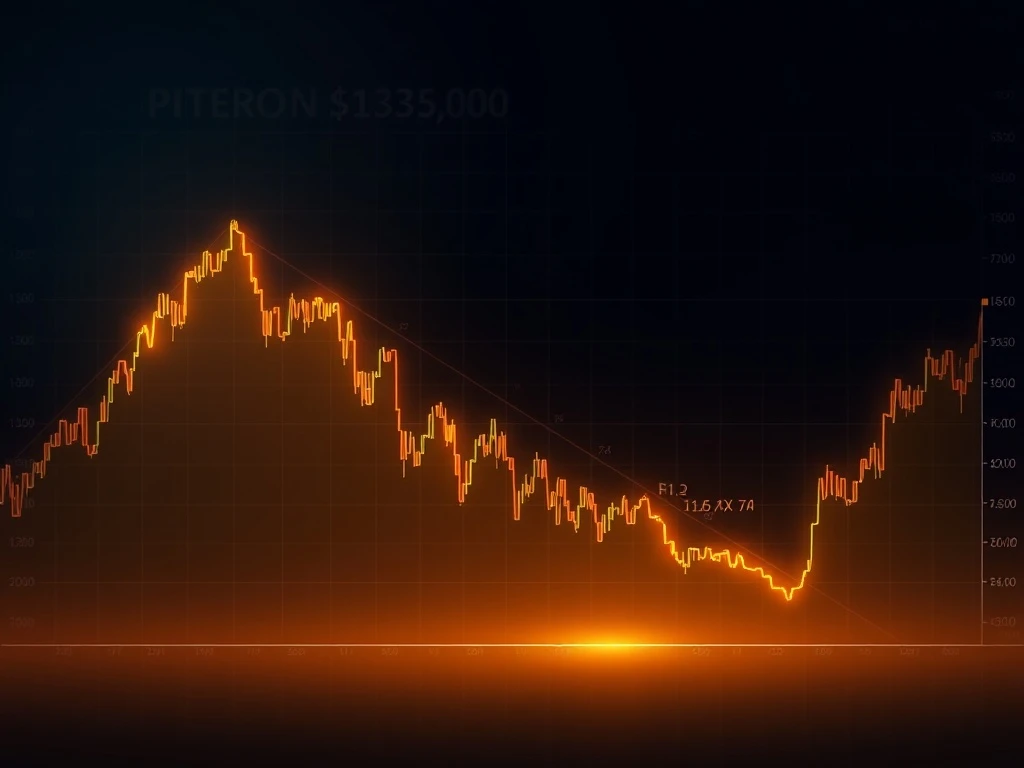Bitcoin Price Dip: Unveiling Critical Support at $113,000 Amid Market Shifts

The cryptocurrency market is once again testing the resilience of its cornerstone asset, Bitcoin. A recent 2% Bitcoin price dip has sent ripples through the digital asset landscape, sparking intense discussions among traders and analysts. This isn’t just a minor fluctuation; it’s a pivotal moment revealing deeper market mechanics, particularly the absorption of bid liquidity as BTC re-evaluates its footing around the critical $113,000 support level. Understanding these dynamics is crucial for anyone navigating the fast-paced world of digital assets.
Understanding the Recent Bitcoin Price Dip
Following a period of anticipation and a brief climb above $120,000 in early June 2025, Bitcoin (BTC) experienced a sharp correction, plummeting over 2% to the $113,000 mark. This sudden movement wasn’t entirely unexpected for seasoned observers. Market commentator Michaël van de Poppe characterized the earlier rally to $120,000 not as a genuine breakout, but rather a ‘liquidity sweep’ – a move designed to trigger stop-loss orders and trap overly eager buyers before reversing direction. Such maneuvers are common in markets with high leverage and elevated open interest, indicating a clearing of positions before a more sustainable trend can emerge. The recent Bitcoin price dip, therefore, aligns with a classic technical pattern of retesting lower range boundaries after an unsustainable upward push.
Key takeaways from this price action include:
- Brief Ascent and Reversal: BTC’s short-lived surge past $120,000 was quickly followed by a significant pullback.
- Liquidity Sweep Confirmation: Analysts view the $120,000 move as a strategic liquidity grab rather than a fundamental shift in momentum.
- Consolidation Needs: The market appears to be seeking a period of consolidation, suggesting further testing of lower price levels before a sustained upward trajectory.
Why BTC Support at $113,000 Matters
The $113,000 level has emerged as a crucial psychological and technical threshold for Bitcoin. This price point is not arbitrary; it aligns with significant Fibonacci retracement levels, which many analysts use to identify potential reversal or consolidation zones. Analyst Crypto Virtuos, for instance, projected that a 6-7% correction could indeed push prices to this level before a potential rebound. For many traders, the ability of BTC support at $113,000 to hold firm will be a key indicator of Bitcoin’s near-term strength. A sustained breach below this level could signal further downside, while a strong bounce could confirm it as a robust foundation for future gains. The market is now in a critical phase where this support level will be rigorously tested by both buying and selling pressure.
The Role of Bid Liquidity in Current Market Dynamics
One of the most compelling aspects of the recent price action is the surge in ‘bid liquidity absorption.’ This refers to the phenomenon where a significant volume of buy orders (bids) are placed at lower price points, effectively ‘absorbing’ the selling pressure as prices dip. This isn’t just passive buying; it reflects active accumulation by both institutional and retail participants who see the Bitcoin price dip as an opportunity to acquire BTC at a discount. In markets with elevated open interest, such as the current crypto landscape, volatility often triggers these liquidity grabs. As prices fall, more bids are activated, creating a ‘floor’ that can prevent steeper declines. This dynamic highlights the underlying demand for Bitcoin, even amidst short-term turbulence, as market participants strategically position themselves for potential future appreciation.
Navigating Crypto Market Volatility and Altcoin ‘Froth’
The broader cryptocurrency market is currently characterized by heightened crypto market volatility, as evidenced by significant liquidation events. Over $500 million in liquidations occurred in the past 24 hours alone, with a single $3.97 million ETHUSDT position on Binance being the largest individual event. CoinGlass attributed this to ‘juicy’ leverage dynamics and concentrated liquidity pockets near the spot price, where even modest price movements can trigger cascading effects for overextended long and short positions. Beyond Bitcoin, concerns about ‘froth’ in altcoin markets are also rising. Onchain analytics firm Glassnode warned that record-high open interest (OI) across top altcoins, surpassing $40 billion, has created a ‘reflexive environment.’ This means that sharp corrections in one asset can amplify downside volatility across the entire sector, making altcoins particularly vulnerable to sudden sell-offs. This interconnectedness underscores the need for caution and a nuanced understanding of market dynamics beyond just Bitcoin.
What’s Next? Expert Bitcoin Forecast
Despite the short-term turbulence and concerns about altcoin ‘froth,’ some analysts remain optimistic about Bitcoin’s long-term trajectory. Crypto Virtuos, for example, maintains a Bitcoin forecast suggesting a potential rebound toward $138,000, provided the $113,000 support level holds firm. However, the path to this target is not straightforward and depends heavily on sustained liquidity accumulation at critical thresholds. Traders are closely monitoring the $117,500 level, which has been identified as a key zone for bid liquidity. Michaël van de Poppe’s assessment that the market is ‘back in the range’ implies an ongoing tug-of-war between buyers and sellers, where further dips could trigger more stop-loss orders or forced liquidations. The broader macroeconomic environment, including Wall Street’s risk appetite, continues to influence crypto demand, adding another layer of complexity to Bitcoin’s outlook. As Bitcoin navigates this pivotal phase, market participants are advised to closely monitor on-chain metrics, order-book dynamics, and broader economic indicators for early signals of shifting demand and potential future trends. The interplay between liquidity absorption and price action will ultimately determine whether Bitcoin’s 2025 narrative leans toward prolonged consolidation or ignites a new bullish cycle.
The recent Bitcoin price dip to $113,000 serves as a crucial test for the market’s underlying strength. While it has triggered significant liquidations and highlighted areas of ‘froth’ in altcoins, it has also demonstrated Bitcoin’s capacity to absorb bid liquidity at key support levels. This dynamic interplay between selling pressure and buying interest will dictate Bitcoin’s immediate future. As the market consolidates and re-evaluates, vigilance and a clear understanding of technical and on-chain indicators will be paramount for traders and investors alike. The coming weeks will be instrumental in revealing whether this dip is merely a pause before a larger ascent or a signal for deeper market adjustments.
Frequently Asked Questions (FAQs)
1. What caused the recent Bitcoin price dip?
The recent Bitcoin price dip was primarily triggered by a pullback after a brief surge above $120,000, which analysts characterized as a ‘liquidity sweep’ rather than a genuine breakout. This suggests the market was clearing out over-leveraged positions before potentially finding a more stable direction.
2. What is “bid liquidity absorption” in cryptocurrency markets?
Bid liquidity absorption refers to the process where a large volume of buy orders (bids) at lower price points are executed as prices fall. This effectively ‘absorbs’ selling pressure, indicating strong underlying demand from institutional and retail investors looking to accumulate assets during price corrections.
3. Why is $113,000 a critical support level for Bitcoin?
$113,000 is considered a critical BTC support level because it aligns with significant Fibonacci retracement levels, which are technical indicators used by traders to identify potential areas of support or resistance. Its ability to hold will be a key factor in determining Bitcoin’s near-term price trajectory.
4. What does “altcoin froth” mean for the crypto market?
“Altcoin froth” refers to a state where open interest (OI) in altcoin markets reaches record highs, indicating excessive speculation and leverage. This can make the altcoin sector vulnerable to sharp corrections, as even small price movements can trigger large liquidations, potentially impacting the broader crypto market due to interconnectedness.
5. What are the potential future price targets for Bitcoin according to analysts?
Some analysts, like Crypto Virtuos, project a potential rebound for Bitcoin towards $138,000 if the $113,000 support level holds. However, this Bitcoin forecast is contingent on continued liquidity accumulation and favorable market dynamics.
6. How can traders navigate current crypto market volatility?
To navigate current crypto market volatility, traders are advised to monitor on-chain metrics (like Glassnode data), order-book dynamics for liquidity pockets, and broader macroeconomic factors. Understanding the difference between genuine breakouts and liquidity sweeps, and managing leverage, are also crucial.









